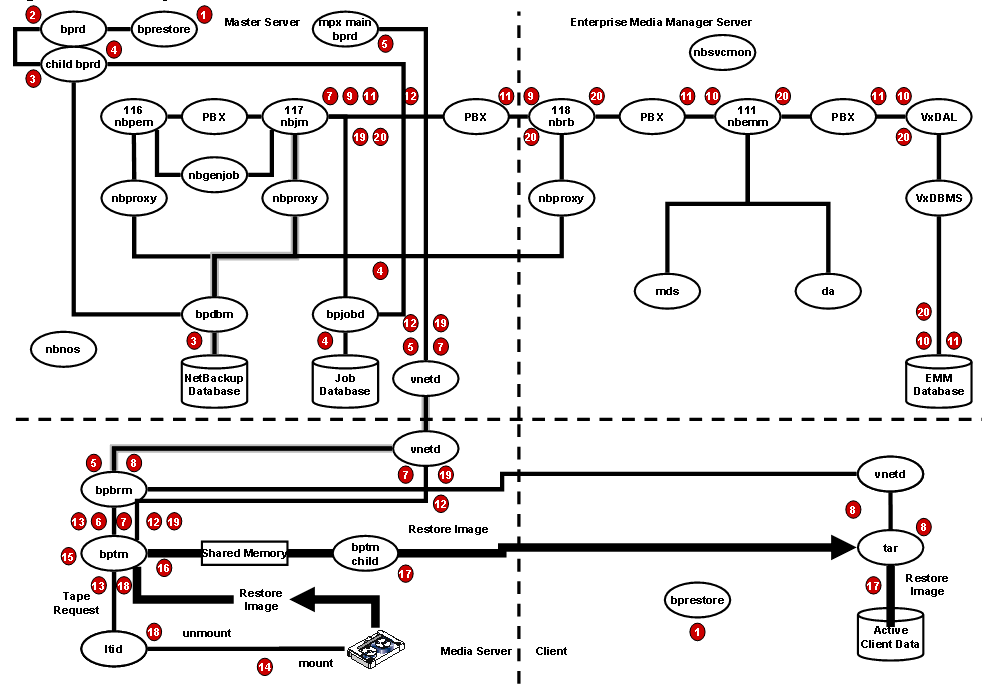NetBackup 6.0 Restore Process Flow
This post provides a process flow for performing a restore with NetBackup. The steps correspond to the information shown in Figure 1 (below). Please refer to Figure 1 while reviewing the steps outlined.
Process Flow

Process Steps
- When the user starts a restore, NetBackup receives the request from the Client's bprestore program which sends a request to the request daemon,
- bprd. This request identifies both the files and Client targeted for the restore. The request daemon spawns a child bprd process to handle the restore request.
- The child bprd process queries the NetBackup images database via bpdbm to obtain the information associated with the backup. This will include the files and Client targeted for the restore, as well as media information which includes the mediaID and Media Server used for the backup. The Master Server then writes a neededimage file.
- A child bprd will then communicate with bpjobd to initiate the restore job. The restore job should now show up in the Activity Monitor. Note that the restore job may show up as “Active” even before the resources have been acquired for the job. The request daemon then spawns a second child bprd process (MPX-MAIN-bprd) to handle the restore request. This MPX-MAIN-bprd child bprd reads the neededimage file to get restore requirements.
- The MPX-MAIN-bprd process then uses vnetd to start the parent backup and restore manager, bpbrm, on the Media Server that holds the media on which the data requested by the restore resides providing the necessary information for the requested restore.
- The bpbrm process on the Media Server initiates both a child bpbrm process and starts either a bptm or a bpdm process. The parent bpbrm passes necessary information to the child bpbrm. For external jobs such as a restore, resources requirements are determined during this pre-processing phase of the job.
- The bptm process on the targeted Media Server will make a request to nbjm on the Master Server via vnetd, naming the media needed for the restore. The resources need to be allocated before the job can proceed.
- The child bpbrm process initiates the tar process on the Client and establishes a connection between the NetBackup tar program on the Client and bptm or bpdm on the Media Server.
- Now that the job has been submitted to the job manager, nbjm, the checks for resources are made. This involves the NetBackup Resource Broker. nbjm contacts the NetBackup Resource Broker, nbrb, on the Enterprise Media Manager Server, to make a resource request.
- nbrb communicates with nbemm, to request, access, and reserve resources as specified by the restore job and other configuration information defined for this Client.
- nbrb returns the resource allocation to nbjm.
- nbjm passes the resource information retrieved by the nbrb service to bptm on the targeted Media Server. The bptm process on the Media Server obtains the location of the data which includes the media ID or file path and any other resource information necessary in order to perform the restore.
- The bptm process on the selected Media Server will SCSI reserve the drive(s) and then issues a mount request to ltid.
- ltid will forward the robotic mount request to tXXd. The tXXd process spawns a child, which issues a drive unload and sends the mount request to tXXcd. The tXXcd process spawns a child to issue the robotic move medium command. The tXXd child polls the drive, waiting for it to become ready and returns to ltid, which updates the mount statistics in the EMM database and then returns to bptm. The bptm process opens the drive path, positions and starts waiting for read data.
- It then spawns a child bptm process, assuming this is a restore to a remote client.
- During retrieval, the original bptm process stores the image block by block in shared memory while the child bptm process
- delivers the data to the tar program on the Client, which writes it to disk. When the data has been restored,
- The parent bptm sends the unmount request to ltid.
- bptm will notify nbjm that the restore is complete.
- nbjm communicates with nbrb to de-allocate resources.
- The child bprd process removes the neededimage file and all processes exit, ending the restore.
